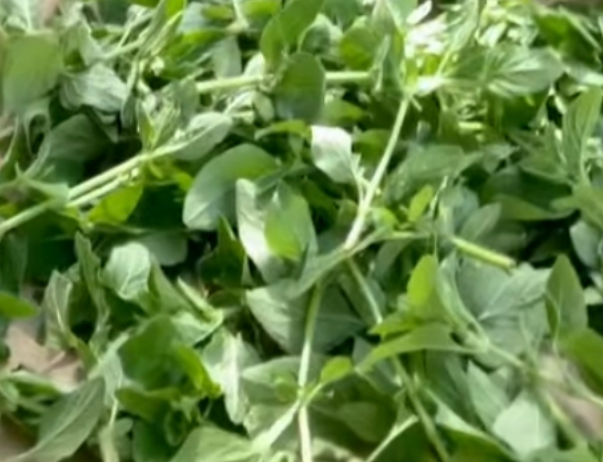
Oregano, Origanum vulgare
Oregano, derive from roman and Greek words, whereas “oros” means mountain and “ganos”means happiness/joy. Due to its exceptional and wonderful aromas and smells, oregano has become widely used in the field of culinary applications. The main objectives of this research project are to conduct an analysis of Oregano hydrosols which were obtained using microwave techniques and thereafter evaluated through gas chromatography-mass spectroscopy (GC-MS).

Oregano, Origanum vulgare
Oregano, scientifically referred to as Origanum vulgare, and belonging to the Lamiaceae family, is highly regarded for its wide ranges of applications. This spices found in various locations in Europe and the United States. Ancient Greek and Roman civilizations used oregano leaves for because of their medicinal and therapeutic properties. Oregano was used to treat various ailments, acting as an antiseptic for skin wounds and relieving muscle pain, it also can effectively treat asthma, diarrhea, and indigestions.
[1] Singletary, Keith. "Oregano: overview of the literature on health benefits."Nutrition Today45.3 (2010): 129-138.
[4] Makri, O. (2002). Cultivation of oregano. Oregano, the genera Origanum and Lippia. Taylor and Francis, London and NewYork, 153-162

Oregano hydrosols were prepared using the microwave extraction method which enhanced extraction efficiency and preservation of delicate volatile compounds that may be lost during traditional distillation methods [2]. 200g of oregano leaves were being plucked from fresh stem and soaked with around 300mL of boiling hot distilled water in the microwave extraction vessel. Following an overnight soaking period, the infused herbaceous material was ready for extraction. To capture the resulting hydrosol droplets, a 300mL beaker was positioned and screwed at the center of the microwave extraction vessel. An ice cone, designed to facilitate optimal condensation, was positioned atop the vessel's lid. The microwave then runs for a duration of 9 minutes. Upon completion of each 9-minute cycle, the extraction vessels were removed from the microwave. The resulting hydrosols collected in the 200mL beaker were then transferred to a clean, dry glass bottle. A new ice cone was then placed and secured on the lid. The extraction process was repeated twice more, with each cycle lasting 9 minutes, to ensure the comprehensive extraction of all volatile and water-soluble components from the oregano.
[2] Nazlić, Marija, et al. "Extraction, Composition and Comparisons–Free Volatile Compounds from Hydrosols of Nine Veronica Taxa."Horticulturae9.1 (2023): 16

Oregano hydrosols were then evaluated using a DB-5 MS column and GC-MS. To eliminate water and big contaminants that can clog the GC column, 1mL of the hydrosols sample was filtered by solid phase extraction (SPE) prior to the analysis leveraging the GC-MS equipment. A second test run was carried out using 5 mL of oregano hydrosols with total of three trials in order to obtain the average peak area for each spike to calculate the concentrations in next step. We noticed there are these little circle spot of essential oil at the top of the bottle after a week of letting the hydrosols remain undisturbed which are not present after the microwave distillation stage of the hydrosol preparation as what shown in Firgure 1. However, the very little amount made it difficult to gather and analyse.

The utilization of GC-MS analysis to examine Oregano hydrosols offers significant insights into their chemical makeup, facilitating the detection and characterization of volatile compounds within the hydrosols. The identification and quantification of individual constituents can be accomplished by comparing obtained mass spectra with established reference databases [3]. It was then found that oregano hydrosols boast an extensive repertoire of bioactive compounds, including linalool, 4-terpineol, Tau-Cardinol which are known for their antioxidant and anti-inflammatory properties.
[3] NIST Chemistry Webbook, SRD 69. Chemical Name Search. (n.d.).https://webbook.nist.gov/chemistry/name-ser/

The chromatogram’s peaks were all recognized by comparing their mass spectra to a database. By contrasting the estimated RI values with the RI values provided for the compound in the literature, their identities were verified and listed in Table 1.
[5]Jafari Khorsand, Ghazaleh, et al. "Natural diversity in phenolic components and antioxidant properties of oregano (Origanum vulgare L.) accessions, grownunder the same conditions." Scientific Reports 12.1 (2022): 5813.
[6] Jafari Khorsand, Ghazaleh, et al. "Natural diversity in phenolic components and antioxidant properties of oregano (Origanum vulgare L.) accessions, grown under the same conditions." Scientific Reports 12.1 (2022): 5813.
[7]Adame-Gallegos, Jaime R., Sergio Andrade-Ochoa, and Guadalupe V. Nevarez. "Potential use of Mexican oregano essential oil against parasite, fungal and bacterial pathogens." Journal of Essential Oil-Bearing Plants 19.3 (2016): 553-567

My name is Rachael Lee, an international student from Malaysia currently in my fourth year of pursuing an Honours bachelor’s degree in chemistry at the University of Ottawa. Having the opportunity to volunteer at John L. Holmes Mass Spectrometry Facility not only allows me to develop my practical skills in analytical chemistry but also provides an invaluable platform for me to learn more about mass spectrometry and analytical chemistry. Moreover, with the aid of gas chromatography-mass spectrometry which allows examination of the chemicals contained in the hydrosols of various raw materials, I am thrilled to pursue analyzing additional plant samples using the methods I have acquired from this experience.
